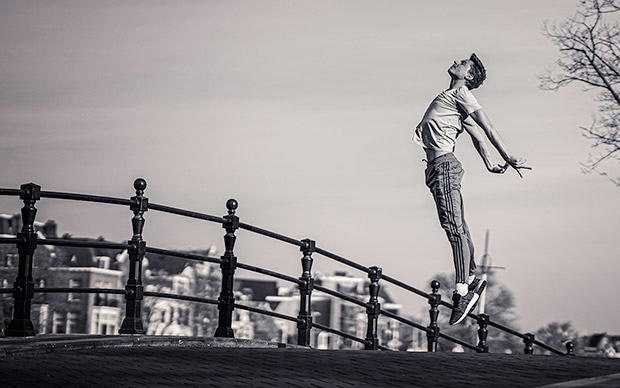
© Altin Kaftira. (Click image for larger version)
Dutch National Ballet
Digital works created in Lockdown
Hold On (★★★✰✰)
Ballerina dances in the Empty Streets of Amsterdam (★★★✰✰)
Gently Quiet (★★★★✰)
Safe Distance Ballet (★★✰✰✰)
Prometheus Project: Eagle (★★★★✰), Prometheus’s Flame (★★★★★),
Avec Le Temps (★★★★✰)
April – June 2020
www.operaballet.nl
Devoid of live performance, virtually every ballet company across the globe has been actively channelling content across various digital platforms through the spring and early summer; mostly – and understandably – attached to pleas for donations to their various relief funds, trying to bolster coffers laid bare by the lack of ticket sales. Invariably, companies have opened up their archive to showcase past performances but one company – more than any other – has used the lockdown to get out and about and film new work.
Dutch National Ballet’s response to the age of coronavirus started as every other company; launching an online platform on 27 March entitled “Keep on Singing and Dancing – Stay Safe” by opening up their archive, including Alexei Ratmansky’s Don Quichot and providing access to online classes by choreographer Ernst Meisner, the artistic coordinator of the Dutch National Ballet (DNB) Junior Company.
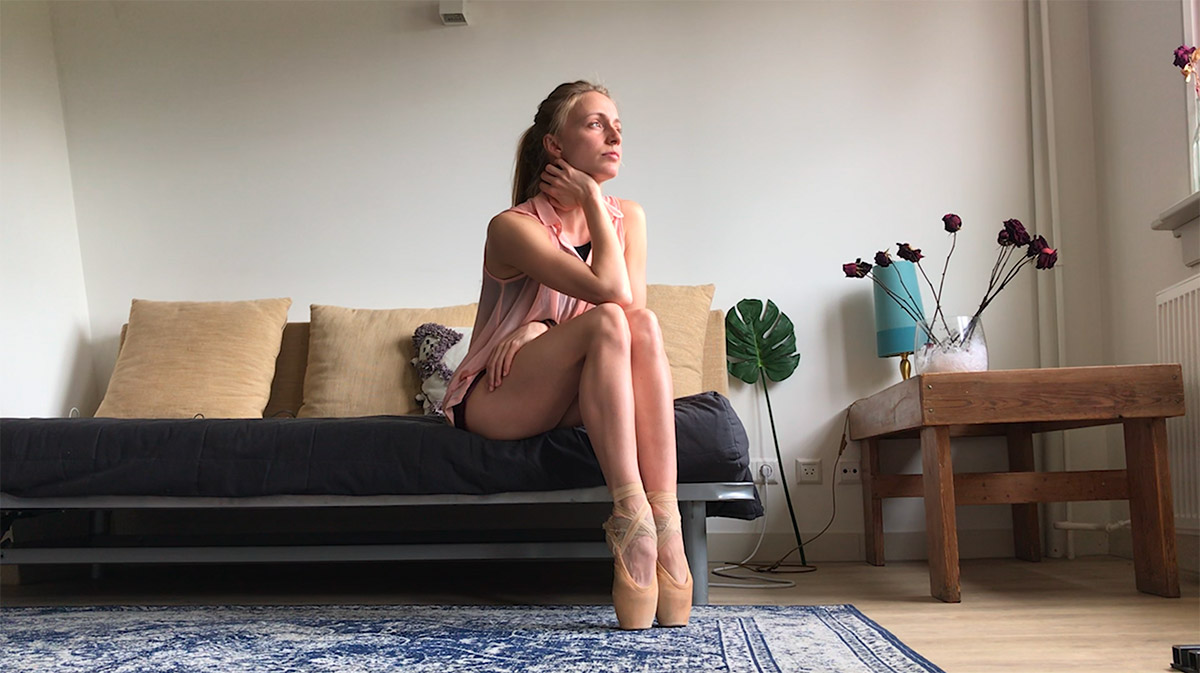
© Het Nationale Ballet. (Click image for larger version)
This access to existing material filmed onstage quickly transitioned to accommodate new work filmed during lockdown, beginning in April with a work set to the pop song Hold On by Dutch band, Di-Rect. Milena Sidorova’s choreography begins with sequential shots of four dancers sitting or lying on their sofas before cutting to a pile of books (Harry Potter and Darcey Bussell to the fore) covering a girl in a bath, apparently wearing little more than sunglasses, and then quickly on to another ballerina pacing the kitchen floor en pointe.
As Di-Rect’s lyrics speak of the walls closing in and not being satisfied with what we had before, the film introduces fast cuts of several dancers alone in very tidy rooms, many literally pressing against the walls as a plea for escape (Sidorova used 25 dancers in total). They dance in hallways, bedrooms, living rooms; on wooden and tiled floors; stretched out on the ground, twirling in pirouettes or reaching out with pointed feet in arabesque. One notices small details of everyday life: for some reason a pot plant sits in a bag on the floor – was it just purchased? Is it on the move? An empty pet cage adorns a sparsely furnished room; a standard lamp is lit despite the daylight; a guy wears clashing odd socks; and, bizarrely, a small decorated Christmas tree sits on a coffee table.
The natural spatial limitations included one dancer, performing in his bedroom, clattering against a mirror on the wall, which, luckily, remained in situ. Eventually, as the singer reaches a crescendo, the cameras (literally one supposes) “zoom” into rapidly changing double screens, then multiple squares of synchronised movement, eventually building to a grid of fifteen tiny boxes, montaged by Altin Kaftira, fading out one-by-one with the song’s final refrain. [Hold On: ★★★✰✰]
April also saw the release of Ballerina dances in the Empty Streets of Amsterdam, an independent project by director, Sasho Pramatarov, featuring DNB soloist, Floor Eimers, and violinist, Marc Daniel Van Biemen. This very professional short film was co-promoted by the Amsterdam Concertgebouw and DNB and features great camerawork (by Mitchell Van der Hoef), initially alternating between Van Biemen playing in the empty Concertgebouw and Amsterdam’s deserted streets, subways and canals. Ninety seconds into the five-minute film, Eimers – dressed in a white wrap-around trouser suit and wearing pointe shoes – steps onto a small bridge over a canal and with consecutive arabesques uses the bridge’s old black handrails as a barre to traverse the screen in elegant fashion.
The director likes pigeons (no doubt symbolising the absence of people) and there are several shots of them fluttering up from the streets and squares. The light suggests early morning with Eimers on a journey, always moving forward whether in the middle of an empty road, canalside or on the rim of an ornamental pond, frequently intercut with the bearded violinist in his well-lit theatre, playing a haunting solo by Bob Zimmerman. He is her destination and soon Eimers is skipping lightly and elegantly down the stairs and through the Concertgebouw’s corridors, pushing doors open with a flourish before pirouetting down the aisle to ensure that dance and music will once again meet. This enigmatic work ends with Eimers reaching her hand out to Van Biemen in a burst of light that diffuses to reveal the hashtag #ARTCONNECTSUS. [Ballerina dances in the Empty Streets of Amsterdam: ★★★✰✰]
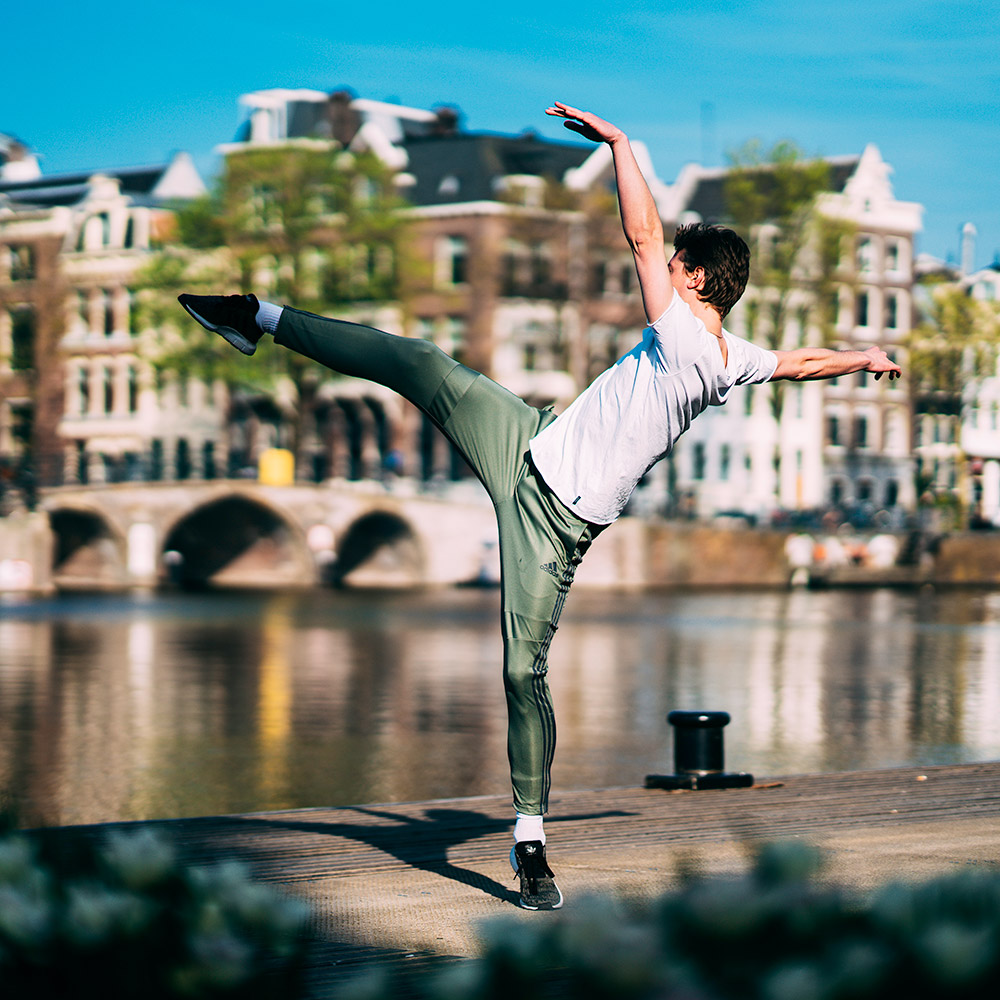
© Altin Kaftira. (Click image for larger version)
Next up, in early June, was Gently Quiet, which provided another opportunity to match dance against the empty cityscape of Amsterdam. This collaboration between filmmaker, Altin Kaftira, and Peter Leung – a British choreographer currently engaged as DNB’s Young Creative Associate – yielded eleven short films, each featuring a different company dancer, shot around several landmarks in the apparently deserted city. Given the ability to move freely outdoors, Leung establishes a counter-intuitive constraint by stationing each dancer on a small square of dance floor. His choreography, although necessarily grounded, has a smooth and subtle range of sinuous, rolling, folding movement, which when elements of the eleven sections are composited into Kaftira’s unified film has an elegant and holistic appeal, as if the essence of these movements is being passed in a single continuum from one dancer to the next. Eventually, the performers are united on a jetty by the River Amstel. The gentleness of the piano music by Setareh Nafisi and Nicholas Robert Thayer is a perfect aural backdrop. Each of the eleven variations from Gently Quiet is being released on a weekly basis during lockdown. [Gently Quiet: ★★★★✰]

© Lesley Weitjes. (Click image for larger version)
Barely a week later – on 12 June – the company released another new digital film in Safe Distance Ballet, a collaboration with G-Star RAW, a Dutch designer clothing company, which visualises the new reality of social distancing as an artistic concept, inspired by a 3-metre wide denim tutu (the ultimate social distancing dance tool), worn by Kira Hilli. With choreography by Remi Wörtmeyer, the brief film is directed by Mathieu Gremillet, as the dancers perform in a skateboard park, an underpass and on the bridge besides the Opera House before coming inside and onto a black stage. Hilli’s socially-distanced partner is Manu Kumar and they are supported by another six colleagues, all performing to the dramatic electronic music with cello solo by Joris Voorn and Boy Bianchi. The final image of Hilli, filmed from overhead, as if a blonde spindle in a giant wheel, rotating on the stage with Kumar enclosing her with a manèges of steps and jumps was particularly memorable. [Safe Distance Ballet: ★★✰✰✰]

© Hans Gerritsen. (Click image for larger version)
Three days’ later, on 15 June, the company presented the online world premiere of the Prometheus Project as part of the Holland Festival online programme 2.0-2.0. Prior to lockdown, DNB had planned to present a triple bill during the live festival to celebrate the 250th anniversary of Beethoven’s birthday, including a new interpretation of the Beethoven ballet Die Geschöpfe des Prometheus, about the myth of Prometheus who out of love for mankind, defied the gods by stealing their fire and sharing it with man. This new production was conceived as a joint project for three choreographers closely associated with DNB: Wubkje Kuindersma, Ernst Meisner and Remi Wörtmeyer. Covid-19 drove the Festival online and the three choreographers each created a filmed solo inspired by the myth of Prometheus, set to different parts of Beethoven’s 32 variations in c-minor for piano, performed by Michael Mouratsch. Each film was once again directed by Kaftira.
Meisner’s Eagle was a powerful solo for Sem Sjouke, his upper torso naked apart from a pair of black wings strapped discretely around his shoulders. Meisner’s inspiration came from the myth that Prometheus was severely punished by the gods for stealing their fire. He was bound to a rock, where each day an eagle was sent to eat his liver, which would then grow back overnight to be eaten again the next day. Rotating movements (plentiful jetés en tournant) suggested flight punctuated by paused poses that seemed to illustrate the navigation of a journey above clouds (represented by a layer of dry ice against a dark background) and concluding with a slow motion leap into the abyss. [Eagle: ★★★★✰]

© Hans Gerritsen. (Click image for larger version)
Wings are replaced by candles as the leit motif for Wörtmeyer’s solo, Prometheus’s Flame, performed by Erica Horwood. It opens with Kaftira’s close-up on Horwood’s face, holding a candle in front of her, and speaking lines from Mary Shelley’s Frankenstein as if she really meant them – “I have love in me, the likes of which you can scarcely imagine and rage the likes of which you would not believe. If I cannot satify the one, I will indulge the other.”
Settling the candle on the floor against her flexed foot (she wears pointe shoes) to join a sequenced matrix of many candles, Horwood dances a powerful pointe-based solo, reflecting the insistent piano ripples; the camera pans to her head and upper body and movement transfers to her arms and hands flowing around and above her head. A moving camera follows the flame-haired dancer (she wears a similarly coloured leotard) around the candle-lit lanes like an intense but elegant game of Pacman, emphasised by occasional shots from overhead, before she comes to rest on her left knee and right hand, with her right leg en pointe, folded over her arm, directly in front of a candle, and speaking more text – “Beware, I’m fearless and therefore powerful” – before blowing out the candle into a black void. I believed her. This was a brief work of remarkable imagery, powerfully performed. [Prometheus’s Flame: ★★★★★]
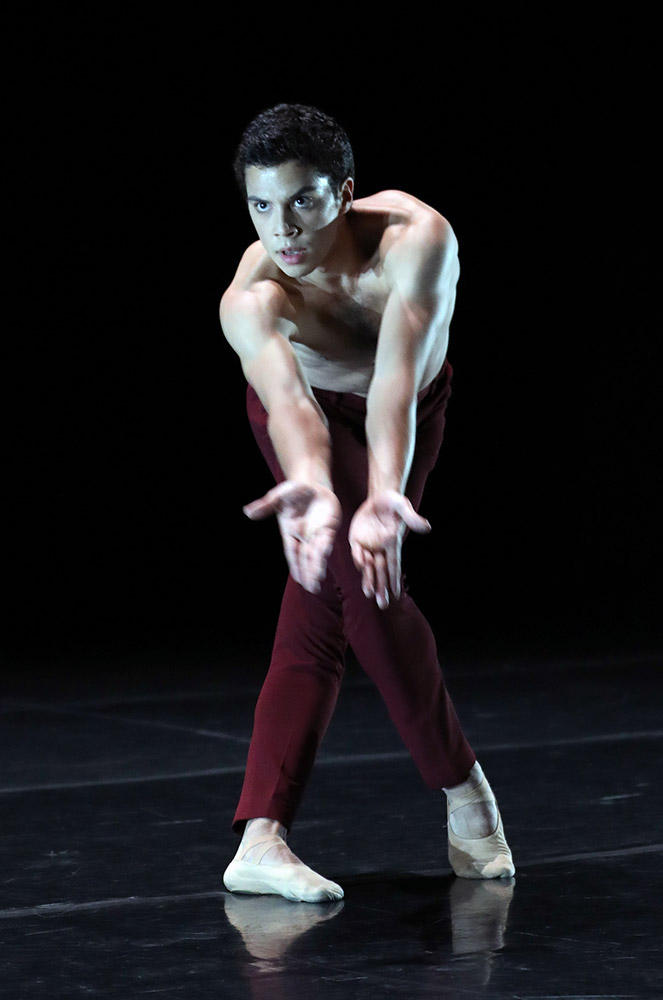
© Hans Gerritsen. (Click image for larger version)
The final part of this Promethean triptych was Wubkje Kuindersma’s Prometheus, a solo for Timothy Van Poucke, also naked to the waist. This was the least adorned piece, with no design accoutrements, relying on the simple classicism of Kuindersma’s choreography, which fully utilised the space, alongside Kaftira’s roving camerawork, heavily focused on the muscular topography of Van Poucke’s back. As he devours the space with his feet, Van Poucke also seems to wrap himself in it, using his arms to gather the unseen kinaesthetic aura around him by pulling it into his body; reaching out to balance something invisible on the palms of his hand before bouncing it up and down, while all the time stepping backwards. A final allegro sequence of arabesque with his back deeply arched, leading to a split sideways jump, jeté en tournant, fouettés and pirouettes brought the camera to close on the ridged landscape of that back. [Prometheus: ★★★✰✰]
And, finally (for now, at least) another choreographer very closely associated with DNB, Annabelle Lopez Ochoa (her full-length Frida premiered in Amsterdam just this February – it seems years’ ago now) produced her second zoom choreography entitled Avec Le Temps for Jingjing Mao and Rémy Catalan, which premiered on 29 June. Beginning with the couple bouncing and lying on their bed, falling on their chests while arching their legs back over their bodies (it’s the first world premiere I have seen on a bed rather than a stage). They move into a room devoid of furniture, surrounded by floor-to-ceiling windows; obviously in a high-rise apartment, with security railings outside the glazing. The choreographer hides them in window alcoves so that just their arms flutter into sight. And, then from being side-by-side indoors, they are suddenly on a beach, running hand-in-hand towards the sea and partnering with an upside-down lift while paddling in the gentle waves.
Avec le temps from annabelle lopez ochoa on Vimeo.
Filmed in black-and-white, there is a vintage feel to Ochoa’s own camerawork and editing (is there no end to this woman’s talent), which creates a kaleidoscopic image of the pair in an invisible split screen. They return seamlessly, still in their swimwear, to bed, with closed eyes and the sensuality of touch, while memories of the waves drift over and through them. The work is choreographed to a song (also entitled Avec le Temps) by Léo Ferré, as interpreted soulfully by the Dutch pop star, Wende (who appeared live onstage singing her own music in Lopez Ochoa’s blistering Last Resistance for DNB). [Avec Le Temps: ★★★★✰]
It has been a long and frustrating wait for live performance but ballet companies all over the world have opened up their vaults to fill the void although none has presented more new work – in digital format – than Dutch National Ballet, with much credit to their in-house filmmaker, Altin Kaftira. I write this at the beginning of July and something tells me that there will be more to come.













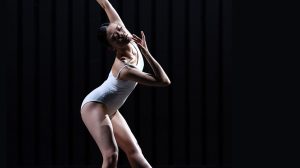
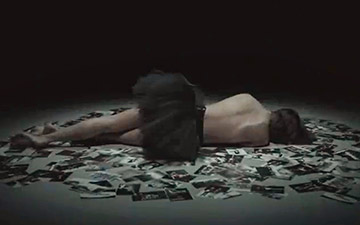
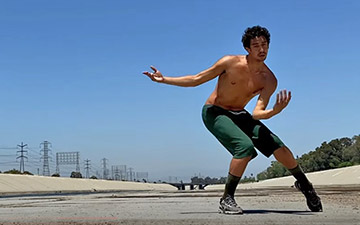

You must be logged in to post a comment.